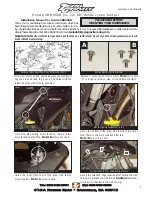
2
Failure to follow these instructions may cause non
-warranty property damage, personal injury or even
death.
Safe towing practices
continued from preceding page
releasing the locking mechanisms, to keep from being hit
by the towed vehicle.
•
Do not drill a second hole in the shank of any tow
bar or hitch accessory.
If the hole in the shank does
not align to the
hole in the hitch
receiver: 1) pur-
chase a hitch
a c c e s s o r y o f
the appropriate
length; or 2) call
ROADMASTER
technical sup-
port.
D r i l l i n g a
second hole will
weaken the steel. The shank may break during tow-
ing, which will cause the towed vehicle to separate.
• Always use safety cables when towing.
The safety
cables must connect the towed vehicle to the towing ve-
hicle frame to frame.
Use only 6,000 pound or heavier rated safety cables.
Additionally, check to ensure that the safety cables are
the proper length. Refer to the sections titled “How to use
safety cables” and “Proper installation of safety cables”
for further information.
• Check the motorhome turning radius.
Some motor-
home chassis have such a tight turning radius that you
can damage your motorhome, towed vehicle or tow bar
while turning too sharply. Before getting on the road with
your towed vehicle, you should test your turning radius
in an empty parking lot.
With the towed vehicle attached, have someone watch
as you slowly turn sharply to see whether you have this
potential problem. If you do, note how far you can safely
turn the motorhome’s steering wheel and be sure not to
turn it further when towing. Damage that results from turn-
ing too sharply is not covered by warranty.
• Never use the tow bar to tow more than one ve-
hicle.
In some states it is legal to have one vehicle towing
more than just one vehicle (for example, a truck which is
towing a trailer which is towing a boat). However, when
using a tow bar, never tow more than one vehicle or non-
warranty damage or injury may result.
• The tow bar stinger fits motorhome hitch receivers
with two-inch inner diameters.
If the motorhome hitch
receiver is a larger size, attach a two-inch adaptor sleeve
(not supplied) to the hitch receiver.
Damage to the tow bar stinger or other components of
the tow bar, abnormal wear patterns on the towed vehicle’s
tires, as well as other, consequential damage may result
if an adaptor sleeve is not used.
• Keep the tow bar clean and well-lubricated.
As is
the case with most precision equipment, frequent clean-
ing and care results in better performance and longevity.
Refer to the section titled “Care and cleaning” for further
information.
Towing vibrations will force the linch pins out unless
they are properly locked in place. Refer to Figure 1.
Failure to properly attach and lock all linch pins
will result in the loss of the towed vehicle, which may
cause property damage, personal injury or even death.
Figure 1
SNAP
GAP
SNAP
GAP
If the ring does not snap against the pin, spin
the pin around and flip the ring to the other side.





























